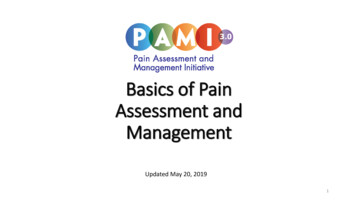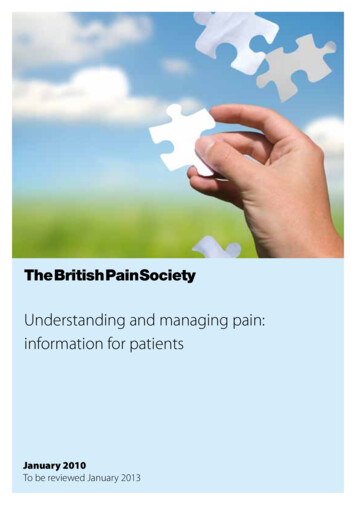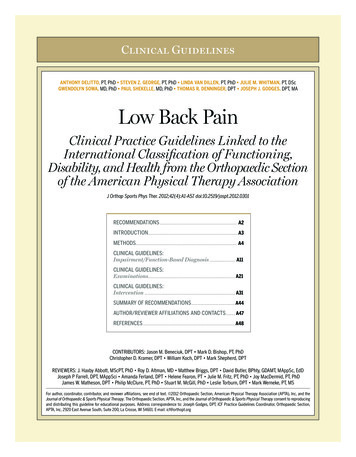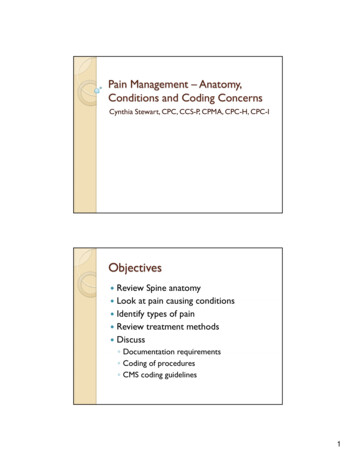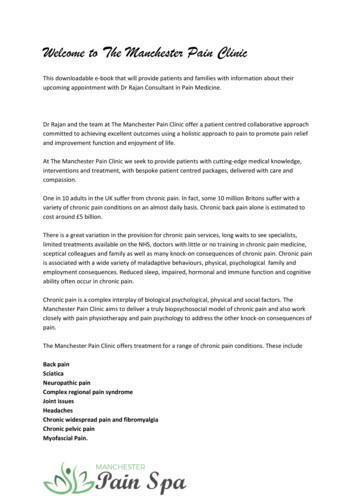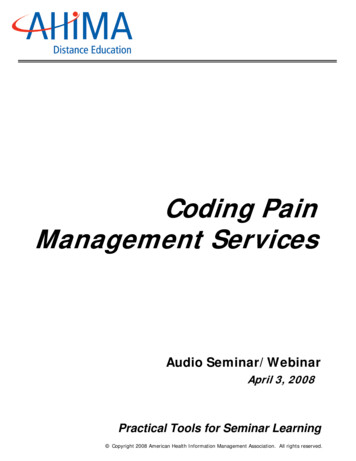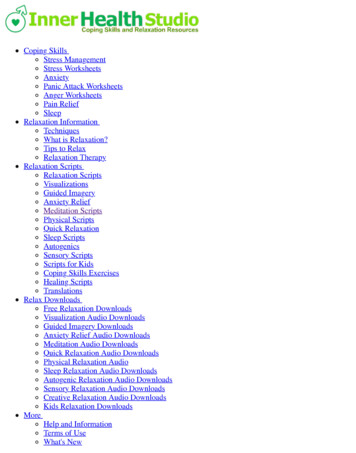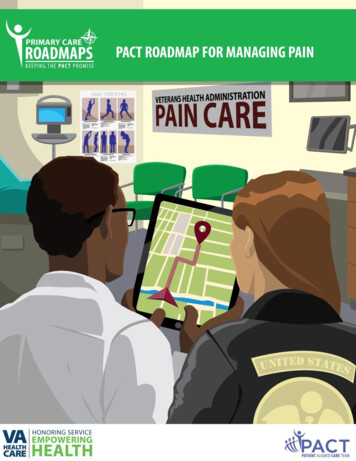
Transcription
1
TABLE OF CONTENTSRoadmap Overview . 3Prologue . 4Facility & Primary Care Leadership . 9Strategy A: Establish a Shared Vision and Infrastructure .10Strategy B: Establish Pain Care Forums .11Strategy C: Identify Key Players to Help Implement the Roadmap.13PACT Members . 14Strategy A: Identify Gaps, Resources and Build Relationships .15Strategy B: Educate Team Members .16Strategy C: Implement Team Based, Stepped Pain Care .20Strategy D: Educate Veterans, Families, & Caregivers .23Strategy E: Integrate Non-pharmacological Pain Care Modalities .25Strategy F: Use Pain Medications & Procedures Rationally .27Strategy G: Implement a Performance Improvement Program .31Strategy H: Develop Processes for Managing Complex Pain Scenarios .33Appendix A: Gap Analysis and Implementation Checklist . 35Facility and Primary Care Leadership Checklist. 35PACT Members Checklist . 37APPENDIX B: CONSTRUCTION CREW . 432January 2018
ROADMAP OVERVIEWIN THISDOCUMENTYOU WILLFIND:The Office of Primary Care (PC), incollaboration with other pain care teammembers and stakeholders, has created thisPACT Roadmap for Managing Pain (PainRoadmap), to assist PACTs in establishing theprocesses and relationships needed toprovide safe and effective team-based,stepped pain care.Tailored Strategies for keystakeholders to implement thePain Roadmap in their settingTips, Tricks and Advice to supportimplementation of the RoadmapTools & Resources offeringadditional pain managementinformationThis Roadmap is intendedfor two key audiences:Facility & PrimaryCare LeadershipPACTMembersHow this Roadmap Benefits Users:FACILITY & PRIMARYCARE LEADERSPages 9-13: Three key strategies and supporting information to use in building a foundation forgood pain carePage 35-36: Use the leadership portion of the gap analysis and implementation checklist toidentify leadership pain care gaps and track implementation progress.This document will help Facility andPrimary Care Leaders more clearlydefine a pain care vision andestablish the support structuresneeded to successfully implementthe Pain Roadmap.PACT MEMBERSThis document will provide PACTMembers with specific strategiesand tactics they can use ininteractions with other pain careteam members and Veterans topromote good pain care.Pages 14-34 Eight strategies and supporting information to use in developing team-based,stepped pain care processesPage 37-42: Use the PACT member portion of the gap analysis and implementation checklist toidentify PACT pain care gaps and track roadmap implementation progress.3January 2018
PROLOGUEPACT Roadmap for Managing Pain: What it is and how to use itIntroductionAre you tugged in so many directions that you’re not able to recognize the full impact pain ishaving on your Veterans’ quality of life? Do competing priorities make it difficult to addressyour Veterans’ full range of bio-psycho-social-spiritual needs? Would you like to learn how toprovide patient centered, team based, stepped pain care in a whole health approach? Tocoach and guide Veterans to achieve what matters most to them while managing their painand living their life to the fullest? To maximize the participation of all team members in paincare? The PACT Roadmap for Managing Pain (also known as the Pain Roadmap) can help youaccomplish these goals and more by providing a pathway for transforming pain care.As you begin this Roadmap journey, please take 7 minutes out of your busy day and view thebeginning of an interactive video at: l.Ask yourself these questions: Do I sometimes let the daily pressures of a busy clinic dull mysensitivity to my Veterans? Am I aware of the non-verbal cues that my Veterans may use tocommunicate that all is not well? Do my pre-conceived thoughts and beliefs regarding howpain should be experienced leave Veterans feeling demoralized or that they are not heard?Then, 1) watch the rest of the video which simulates how four members of the health careteam can truly work together to provide exemplary pain care, and 2) spend some time withthis Roadmap, which draws on the wisdom of research, best practices and muchexperience/expertise from our national pain subject matter experts. Their strategies, tips,tools and resources will enable your PACT to work closely together to develop an organizedapproach to pain management that empowers and equips Veterans to take charge of theirhealth and well-being and to live their life to the fullest.BackgroundPain is the most common reason individuals seek medical care. When severe, it is oftenassociated with and worsened by significant impairment in physical, psychological, social andvocational functioning. Pain is more common in Veterans (particularly in younger Veteransand Veterans who served during recent conflicts) than in the non-veteran US population,more often severe, and in the context of comorbidities. A 2017 study (Nahin RL) showed thatVeterans experience pain at rates exceeding those in the general population. An estimated65.5% of United States Veterans reported pain the previous 3 months compared with 56.4%of non-Veterans. 9.1% of Veterans reported severe pain compared with 6.4% of nonVeterans. Pain severity and co-concurrence with mental health comorbidities result in highimpact pain (i.e. associated with substantial restriction of participation in work, social, and4January 2018
self-care activities). Pain conditions independently increase risk for suicidal ideation andsuicide attempts and chronic pain is estimated to double the risk of death by suicide.According to the Behavioral Health Autopsy report (2015) “The most frequently identified riskfactor among Veterans who died by suicide was pain”.The United States is in the midst of an opioid overdose epidemic. The Centers for DiseaseControl and Prevention (CDC) reports that from 1999 to 2015, more than 183,000 people diedin the U.S. from overdoses related to prescription opioids. Opioids killed more than 42,000people in 2016, more than any year on record. 91 Americans die from an opioid overdoseevery day and 40% of all opioid overdose deaths involve a prescription opioid. Overdose is notthe only risk related to prescription opioids. Misuse, abuse, and opioid use disorder(addiction) are also potential dangers. Anyone who takes prescription opioids can becomeaddicted to them.To address the prevalence and impact of pain, VHA employs a Stepped-Care Model of PainManagement (SCM-PM) as a strategy to provide a continuum of effective pain care forVeterans with both acute (pain that comes on quickly, can be severe, but lasts a relativelyshort time) and chronic pain (ongoing or recurrent pain, lasting beyond the usual course ofacute illness or injury, and in some instances, the Veteran’s lifetime). The SCM-PMemphasizes an individualized approach to pain management in which interventions arestepped up with increasing complexity and need. Step One includes self-care/selfmanagement and managing common pain conditions in Primary Care. Good acute pain careduring injury/disease management promotes healing and disease modification with the goalof restoring and maintaining a Veteran’s level of functioning and quality of life. Well-managedacute pain care is important to prevent progression to chronic pain. When pain persists,changes (known as “neuroplasticity”) occur in the brain that can impact pain perception,cognition, sleep, anxiety, emotions, substance use, and other aspects of a person’s life. Thedegree of impact is determined by the interaction of a person’s somatic pain condition withtheir emotions and interpersonal and physical environments. Step Two of the SCM-PM bringsin secondary/specialty services such as Pain Medicine, Physical Medicine and Rehabilitation,Polytrauma, and Pain Psychology for occasional short-term co-management. Step Threeprogresses to tertiary/advanced services such as Pain Medicine diagnostics and PainRehabilitation programs accredited by the Commission on Accreditation of RehabilitationFacilities (CARF).A population-based, stepped approach to pain management focuses on primary, secondaryand tertiary prevention and the partnership of an informed Veteran and a proactive healthcare system. Team-based care is emphasized and a “Whole Health” approach is incorporatedto empower and equip Veterans to take charge of their health and well-being and to live theirlife to the fullest. The “Whole Health” approach includes conventional treatment, but alsofocuses on self-empowerment, self-care/self-management, and complementary andintegrative health modalities. The “Whole Health” approach, through formal Personal HealthPlanning or informally asking the Veteran “what do you want your health for?” internallymotivates further action whether it is primary, secondary or tertiary prevention.5January 2018
Since most pain care is provided in the primary care setting it is essential for PACTs to developeffective Veteran-centered, team-based processes for providing and coordinating pain care.This Roadmap incorporates principles from several pain care documents1 and providesactions, tips, tools and resources for PACTs to use in developing these processes using a“Whole Health” approach and the SCM-PM. It also builds upon concepts introduced in thePACT Implementation Roadmap and the PACT Handbook to prepare PACTs to engage andassist Veterans in actively managing their pain, to provide comprehensive pain care, toconnect with secondary/specialty and tertiary/advanced pain services when needed, toevaluate the effectiveness of services provided, and to manage complex pain care scenarios.Primary Objective of the Pain RoadmapTo assist PACTs in establishing the processes and relationships needed to provide team basedcare that results in improved pain care and quality of life for Veterans.How should we use this Pain Roadmap?1) Facility and Primary Care Leaders:See the strategies outlined in the leadership section of the Roadmap. You can facilitate theuse of the VHA SCM-PM and support the implementation of this Roadmap by establishing apain care infrastructure that includes a shared vision for pain care, a forum for on-goingeducation and Whole Health care planning for the entire pain team, and identifying at leastone PACT Pain Champion to operationalize this Roadmap. Make sure you have a fullyfunctional Comprehensive Addiction and Recovery Act (CARA) mandated Pain ManagementTeam. Ensure that Complementary and Integrative Health modalities, Behavioral PainManagement, Physical Medicine and Rehabilitation modalities, Academic Detailing, andSubstance Use Disorder expertise are readily accessible to Primary Care. Support Primary Carewith timely access to pain management expertise through high functioning e-consultationservices, Pain Specialty Clinics, Pain VA-ECHO, and Pain-Telehealth. Consider adding a PainTeam to your primary care clinics for consultation and short-term co-management ofVeterans with complex pain needs. Opioid use disorder frequently occurs in Veterans exposedto long-term opioid therapy, thus it is vital to provide access to substance use disorderexpertise and in selected Veterans, medication assisted treatment. How about an ongoingmeeting where the care for the most complex Veterans at your facility can be discussed withall pain care team members to develop a shared strategy for managing their needs? Thismight be an excellent way to open communication channels between primary care and otherprograms to improve Veteran pain management and quality of life, as measured by increasedVeteran satisfaction, improved pain scores, and less reliance on opioids and benzodiazepines.There is growing evidence that such a transformation of pain care will reduce emergencydepartment visits and admissions, and result in actual long-term cost savings for the facilityand improved well-being for Veterans.1The Institute of Medicine’s report Relieving Pain in America, the National Pain Strategy, the Comprehensive Addictionsand Recovery Act of 2016 (CARA), the VA/DOD Management of Opioid Therapy for Chronic Pain VA/DOD Clinical PracticeGuideline, the VA Academic Detailing Opioid Use Disorder Campaign, and VHA Directive 2009-053 Pain Management.6January 2018
Facility and Primary Care Leadership: Pages 9-132) PACTs:Review this Roadmap with your teamlet and discipline-specific team members to gather theirfeedback and input. Solicit their ideas and together develop a plan to operationalize theRoadmap. Perhaps begin by training your team on the basics of good pain care and make sureeach team member understands their role in providing primary pain care. A great andengaging way to introduce your PACT to the team approach required for excellent pain care isto view together the video “Pathways to Safer Opioid dex.html). This interactive program allows youto experience pain care from four different perspectives: the patient, provider, clinicalpharmacist, and registered nurse. Dramatically illustrated is how taking the time to developstrong relationships with the patient and other team members enhances both the safety andeffectiveness of pain management.Also, make sure your team members are trained and have regular updates in TEACH forSuccess and motivational interviewing. Identify and connect with your PACT Pain Champion,facility CARA mandated Pain Management Team, and Pain Specialty providers to identify VAand non-VA pain care resources. Although most pain care needs can be met in primary care,it’s important to know how to access secondary and tertiary pain services when needed. ThePACT Pain Champion can play a lead role in identifying and establishing relationships andcoordinating care with pain care team members from secondary and tertiary services such asPain Clinics, Pain Medicine, Complementary and Integrative Health, Physical Medicine andRehabilitation, Pain VA- ECHO, Substance Use Disorder (SUD) specialists, Palliative Care,Mental/Behavioral providers, Case Management, Emergency Department, Inpatient Services,and others. Identify forums for bringing the entire pain care team together to discuss Veterancare and develop processes for communication and care coordination. Discuss this Roadmapwith your primary care leaders and PACT Pain Champion and seek their input on the mosteffective ways to implement it. In particular, seek their help aligning facility wide programsand resources for pain care and ask for their thoughts and help to network with relevantvirtual and community programs.PACT Members: Pages 14-347January 2018
Roadmap Format & LayoutThis roadmap is designed to be user friendly and easy to understand.IconDescriptionThe Action Section is designated by the checkboxes.These actions are simple, “checklist-able,” and actionable.The Tips Sections is designated by the lightbulb icon.These are tips, tricks, or advice on how to complete and action or implement thestrategy.The Tools & Resources Section is designated by the tools icon.These are tools and resources to provide additional information or examples to helpteams implement the strategy.The steps outlined in this Roadmap can be implemented incrementally and customized to meet theindividual needs of Veterans. Although the recommendations are based upon broad experience andexpertise in the care of Veterans with pain, this document is intended to evolve and mature overtime, with input and feedback from the VHA community. Questions or feedback related to thisdocument can be directed to VHA 10NC3 Staff@va.gov.Need a definition for some of the terms used in the PACT Roadmap for Managing Pain? See thePACT Roadmap for Managing Pain Glossary of TermsWant more information on managing pain? Check out the PACT Roadmap for Managing PainFrequently Asked Questions (FAQs).Need an alphabetized listing of all the tools and resources included in this Roadmap? See the PACTRoadmap for Managing Pain Compendium of Tools and Resources.8January 2018
FACILITY & PRIMARYCARE LEADERSHIPSuccessful implementation of thePain Roadmap starts with leadershipand the cultivation of the right policies,practices and environment where PACTsare given the tools, resources (to includestaff), and support to be successful. Thissection is designed to assist leaders inmore clearly defining the vision andsupport structures needed tosuccessfully implement the PainRoadmap.How to Use this DocumentUSE the leadership portion of the Gap Analysis and Implementation Checklist onPages 35-36 to identify pain care gaps.READ the entire section and the three key strategies outlined on Pages 10-13.PRIORTIZE strategies based on the results of your gap analysis and therecommended timelines noted within each strategy.TRACK your implementation progress with the leadership portion of the GapAnalysis and Implementation Checklist on Pages 35-36.9January 2018
FACILITY AND PRIMARY CARE LEADERSHIPRESPONSIBILTIESASTRATEGY AEstablish a Shared Vision and InfrastructureStrategy A: Establish a Shared Vision and InfrastructureFacility and Primary Care leaders are encouraged to complete the following action items to develop a common visionfor pain care and support efficient and effective resource and program utilization:TO BEGIN THE PROCESS IN THE FIRST MONTH COMPLETE:Task 1 (all four action items can be completed concurrently) Use the Gap Analysis and Implementation Checklist in Appendix A to identify your facility’s pain care gaps andtrack your progress in implementing this Roadmap. Develop and communicate a shared vision of effective strategies and processes to identify and manage Veteranswith pain and co-occurring conditions. Identify and provide timely access to resources for complementary and integrative health modalities, exerciseand movement therapies, behavioral pain management, physical medicine and rehabilitation modalities,substance use expertise, and for Veterans with opioid use disorder, medication assisted treatments. Know and work with your facility CARA mandated Pain Management Team. (See Tools and Resources sectionbelow for more information CARA mandated Pain Management Teams).IN MONTHS 2 AND 3 COMPLETE:Task 2 (use a variety of training options prioritizing interdisciplinary team based trainings) Ensure PACT and other pain care team members have time for education and training to enhance knowledgeand skills in caring for Veterans with pain and to address negative attitudes, skepticism, stereotyping, and bias.IN MONTHS 4-12 COMPLETE:Task 3 (you may have some of these modalities in place; it may take some time to implement others Support Primary Care with timely access to pain management expertise through high functioning e-consultationservices, Pain Specialty Clinics, Pain VA-ECHO, and Pain-Telehealth (especially important for CBOCs).TIPS, TRICKS, ADVICE Consider an initial face-to-face meeting with critical stakeholders to get their input and support.Your PACT Pain champion, VISN Pain POC, Facility Pain POC, and your facility Pain Committee maybe particularly helpful in analyzing gaps and bringing together ideas for improved pain care at yourfacility. Involve Pain Medicine, Mental Health, Pharmacy, Physical Medicine and Rehabilitation,Substance Use, Integrative Health, VISN and community pain resources, and others as appropriatefor your facility and CBOCs. Be sure to address the pain resource needs of your CBOCs. Provide periodic implementation progress updates to all stakeholders.TOOLS AND RESOURCESSuggestions for creating a shared vision for pain care Offers suggestions for gathering stakeholders todevelop a shared vision for pain care.Pain Management Team Offers information on CARA mandated Pain Management Teams.10January 2018
FACILITY AND PRIMARY CARE LEADERSHIPRESPONSIBILTIESBSTRATEGY BEstablish Pain Care ForumsStrategy B: Establish Pain Care ForumsThe facility’s clinical governing body (typically known as the Clinical Executive Board or Medical Executive Committee)and Primary Care leaders should:THIS ACTION ITEM IS DONE CONCURRENTLY WITH TASK 1 OF SECTION A:Task 1 Ensure there is a fully functioning facility multidisciplinary Pain Management Committee (as mandated in VHADirective 2009-053 Pain Management).THESE ACTION ITEMS SHOULD BE COMPLETED WITHIN 2-3 MONTHS:Task 2 Ensure an interdisciplinary pain management case review forum is available for PACT teamlets and subjectmatter experts (such as Pain Specialty, Mental Health, Substance Use, etc.) to discuss the plan of care forindividual Veterans with complex pain needs. Such a forum will also encourage strong partnerships betweenservices and departments. Ensure the facility CARA mandated Pain Management Team is fully functional (see the Tools and Resourcessection below for more information on CARA Pain Management Teams).TIPS, TRICKS, ADVICE Multidisciplinary Pain Management Committee:a. Is a formal committee with interdisciplinary membership.b. Identifies implementation barriers and works with facility leadership todevelop solutions. Interdisciplinary Case Review Forum:a. Offers opportunities for interdisciplinary input into the plan of care forindividual Veterans.b. May be co-led by PC and Specialty Pain leaders, to include Mental Health.c. Can be set up as a consultative model (F2F or virtual) involving casemanagement. CARA mandated Pain Management Team:a. At a minimum consists of: Medical provider with pain expertise, AddictionMedicine expertise, Behavioral Medicine, and Rehabilitation Medicine.b. Provides evaluation and follow-up, as needed, for Veterans with complexpain conditions.c. Provides pain consultation for medication management and actualprescribing of pain medication, as needed.d. Reviews the plan of care for Veterans with high risk opioid prescriptions and11January 2018
FACILITY AND PRIMARY CARE LEADERSHIPRESPONSIBILTIESBSTRATEGY BEstablish Pain Care Forumsmakes recommendations to clinical providers in concordance with previouslypublished VHA Opioid Safety Initiative requirements for OSI teams.TOOLS AND RESOURCESVHA DIRECTIVE 2009-053 Pain Management This directive provides policy andimplementation procedures for the improvement of pain management consistent with theVHA National Pain Management Strategy and compliance with generally accepted painmanagement standards of care.Suggestions for an Interdisciplinary Case Review Forum This document offerssuggestions for developing a forum for interdisciplinary pain management case review.Pain Management Team This presentation offers information on CARA mandated PainManagement Teams.12January 2018
FACILITY AND PRIMARY CARE LEADERSHIPRESPONSIBILTIESCSTRATEGY CIdentify Key Players to Help Implement the RoadmapStrategy C: Identify Key Players to Help Implement the RoadmapTHIS ACTION ITEM SHOULD BE COMPLETED IN THE FIRST MONTH: Identify and designate at least one local PACT Pain Champion who is respected and knowledgeable about paincare. An enthusiastic PACT Pain Champion can help PACTs learn about pain care, operationalize this Roadmap,and ensure alignment with other pain care team members. VHA memo requires this to be a minimum of 0.25FTEE. (See memo in Tools and Resources section below). Ensure the PACT Pain Champion and the CARA mandated Pain Management Team are integrated. (See the Toolsand Resources section below for more information on CARA mandated Pain Management Teams).TIPS, TRICKS, ADVICE The local PACT Pain Champion should have adequate time to:a. Serve as the Pain Roadmap navigator and guide for PACTs.b. Advise PACTs (to include PACTs at your CBOCs) on how to use all availableresources to provide safe and effective pain care.c. Serve as liaison to other pain care resources/team members.TOOLS AND RESOURCESPACT Pain Champions Describes potential activities for a pain champion.USH Memo on Academic Detailing and Primary Care Pain Champions Paragraph 6 of thismemo directs VISNs to ensure VA medical centers fund 0.25-0.5 FTEE for a Primary CarePain Champion.Pain Management Team This presentation offers information on CARA mandated PainManagement Teams.13January 2018
PACT MEMBERSPACT Members are on the frontlineproviding pain care every day. Asindividual care providers and members ofPACT you need to have access to thestructures, resources, and best practices todeliver good pain care. This section offersPACT Members useful strategies and tacticsto build relationships across the pain carecontinuum and to develop the structuresand processes needed to provide safe andeffective pain care.How to Use this DocumentUSE the PACT Member portion of the Gap Analysis and Implementation Checkliston Pages 37-42 to identify pain care gaps.READ the entire section and the eight key strategies outlined on Pages 15-34.PRIORTIZE strategies based on the results of your gap analysis and therecommended timelines noted within each strategy.TRACK your implementation progress with the PACT Member portion of the GapAnalysis and Implementation Checklist on Pages 37-42.14January 2018
PACT MEMBER RESPONSIBILITIESASTRATEGY AIdentify Gaps, Resources and Build RelationshipsStrategy A: Identify Gaps, Resources and Build RelationshipsTASKS SHOULD BE DONE CONCURRENTLY AND COMPLETED IN THE FIRST MONTH: Identify and connect with your PACT Pain Champion(s) and facility CARA mandated Pain Management Team.(See the Tools and Resources section below for information on PACT Pain Champions and CARA mandated PainManagement Teams). Work with your PACT Pain Champion, facility CARA mandated Pain Management Team, and Pain Specialtyproviders to identify VA and non-VA pain care resources. Begin forming relationships with programs and services (such as Mental Health, Substance Use, CIH/WholeHealth, Physical Medicine and Rehabilitation, etc.) that can help manage Veterans with pain. Use the Gap Analysis and Implementation Checklist in Appendix A to identify your PACT’s pain care gaps andtrack your progress in implementing this Roadmap.TIPS, TRICKS, ADVICE Your PACT Pain Champion, CARA Pain Management Team, VISN CIH for Pain POC, andSpecialty Pain Care staff can assist in identifying pain care resources. Each VISN and facility has a Pain Point of Contact (POC) who can provide informationon local, VISN, and national pain resources. Use the Pain Resources Tool in the Tools and Resources section below to develop aninventory of and contact information for onsite, virtual, VISN, and community paincare resources. See the Tools and Resources section below for a one page view of the strategiesincluded in the PACT Roadmap for Managing Pain.TOOLS AND RESOURCESSample Pain Resources Tool This is a sample template to use in developing an inventoryof and contact information for onsite, virtual, VISN, and community pain care resources.Navigating the PACT Roadmap for Managing Pain A one page flow map of the strategiesincluded in the PACT Roadmap for Managing Pain.Pain Management Team This presentation offers information on CARA mandated PainManagement Teams.PACT Pain Champions Describes potential activities for a pain champion.USH Memo on Academic Detailing and Primary Care Pain Champions Paragraph 6 of thismemo directs VISNs to ensure VA medical centers fund 0.25-0.5 FTEE for a Primary CarePain Champion.15January 2018
PACT MEMBER RESPONSIBILITIESBSTRATEGY BEducate Team MembersStrategy B: Educate Team MembersNow that you have identified your gaps, are knowledgeable of your resources, and have connected with your PACTPain Champion and CARA mandated Pain Management Team begin to implement the Six Essential Elements ofGood Pain Care.Implement Element One of the Six Essential Elements of Good Pain Care: Educate/train all team members to theirdiscipline specific competencies, including team based care in your huddle, in your team meetings and through yourestablished educational processes. Assess training needs of each team member, both initial and ongoing, based on their role in the pain care andtreatment planning process. Educate team members on their role in using a bio-psycho-social-spiritual whole health model to provideprimary pain services that include:a. routinely screening for the presence and intensity of pain and pain’s effects on sleep, mood, stress, andfunction;b. conducting a comprehensive pain assessment when pain is identified;c. developing and deploying a whole health Veteran-centered, integrated, evidence-based plan of care; andd. reassessing the effectiveness of the plan and adjusting as needed. Educate team members on the SCM-PM and ensure they know when to access secondary and te
management and managing common pain conditions in Primary Care. Good acute pain care during injury/disease management promotes healing and disease modification with the goal of restoring and maintaining a Veteran's level of functioning and quality of life. Well-managed acute pain care is important to prevent progression to chronic pain.



